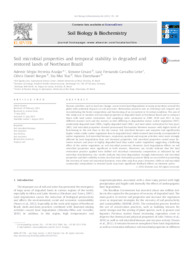Soil microbial properties and temporal stability in degraded and restored lands of Northeast Brazil.
Soil microbial properties and temporal stability in degraded and restored lands of Northeast Brazil.
Author(s): ARAÚJO, A. S. F.; CESARZ, S.; LEITE, L. F. C.; BORGES, C. D.; TSAI, S. M.; EISENHAUER, N.
Summary: Human activities, such as land use change, cause severe land degradation in many ecosystems around the globe with potential impacts on soil processes. Restoration practices aim at reverting such impacts and reconstituting the biotic composition and functioning of an ecosystem to its initial condition. The aim of this study was to monitor soil microbial properties in degraded lands in Northeast Brazil and to compare those with land under restoration. Soil samplings were conducted in 2009, 2010 and 2011 in two different seasons (wet and dry season) at sites differing in degradation status: native vegetation (NAT), moderately degraded land (MDL), highly degraded land (HDL), and land under restoration for four years (RES). Soil microbial properties showed pronounced fluctuations between seasons with higher levels of functioning in the wet than in the dry season. Soil microbial biomass and enzymes had significantly higher values under native vegetation than in degraded land, while restored land mostly corresponded to native vegetation. Soil microbial biomass, respiratory quotient and enzyme activities were more strongly affected by land degradation than soil chemical properties.
Publication year: 2013
Types of publication: Journal article
Unit: Embrapa Mid-North
Observation
Some of Embrapa's publications are published as ePub files. To read them, use or download one of the following free software options to your computer or mobile device. Android: Google Play Books; IOS: iBooks; Windows and Linux: Calibre.
Access other publications
Access the Agricultural Research Database (BDPA) to consult Embrapa's full library collection and records.
Visit Embrapa Bookstore to purchase books and other publications sold by Embrapa.

